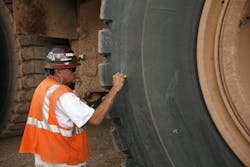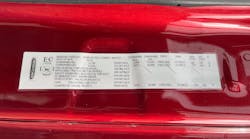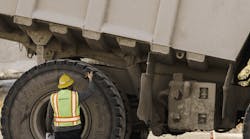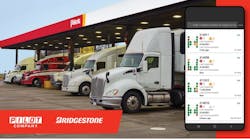Tires are a substantial investment that can be tricky to manage for fleets with both pneumatic-tired earthmovers and over-the-road haulers such as dump trucks, but attention to maintenance and the work environment can keep assets rolling at lower costs.
The most obvious best practice to keep assets up and running, achieve optimal tire performance, and contribute to lower owning and operating costs is proper inflation.
Learn how to manage owning & operating costs at The Construction Equipment Executive Institute.
“Maintaining proper inflation levels is the single-most effective thing you can do to achieve optimal tire performance,” says Eric Matson, manager, Global Field Solutions, OTR, Goodyear Tire & Rubber Company.
Don’t take inflation for granted
Correct inflation pressure impacts tire wear and casing life, and also can help reduce fuel consumption. “Inflation checks should be part of every pre-shift vehicle inspection,” Matson says. “If this isn’t feasible, check your inflation pressure at least once a day.
“Be aware of both over-inflation and under-inflation. Over-inflation can lead to uneven wear and make the tire more susceptible to ruptures when rolling over tough terrain,” Matson says. “Under-inflation causes tires to flex more, which results in internal heat build-up.”
In addition to the checks, be sure to know the load you’re carrying.
“The first step is to specify inflation pressure to match the maximum load each tire is likely to carry, which does not mean automatically inflating tires to the max inflation pressure marked on the sidewall of the tire,” says Gary Schroeder, director of Commercial Vehicle and OEM Sales for Cooper Tire.
“Most of that information comes through data books that share the load capacity versus how much air pressure they should be carrying,” says Tim Easter, director of OTR sales, Yokohama. “If your truck is designed to haul 70 tons, haul 70 tons, not 100 tons.”
Tire selection
Proper tire selection also goes a long way toward running smoothly and keeping costs down.
“Choosing the right kind of tire is critical to getting more miles to removal,” Schroeder says. “What type of tire contractors need depends a great deal on what kind of fleet they operate and where they operate. In general, it’s best to use mixed-service tires with deep treads and cut- and chip-resistant tread compounds in construction applications. These tires feature tread compounds that will resist cutting and tearing from gravel or debris and heavy sidewalls that resist damage from larger objects.”
Also, don’t assume on- and off-road haulers should always lean toward the protection of the most robust off-road tires.
“In some operations, dump trucks can spend a surprisingly high proportion of their time and mileage on the road rather than on rugged job sites,” Schroeder says. “In these cases, open-shoulder drive tires designed for pick-up and delivery service may be the better choice. These tires deliver longer tread wear as they’re designed for highway use and are resistant to scrubbing.”
Schroeder says that with proper tire choice and maintaining tire pressures, operators can not only get more miles to removal, but also can ensure that they maximize the potential for retreading their casings.
What’s under your tires?
It’s also important to consider your running environments—survey your sites.
“Whether performed in-house or by a representative from your tire supplier, construction site audits can be another valuable tool,” says Goodyear’s Matson.
“Take a careful look at your site, as well as the roads leading into and out of it. Are these areas free of rocks and other debris that can cut into tires? How are they manicured? Are there things that can be done, such as laying down gravel, to help improve tire traction? How many curves are your vehicles currently required to navigate, and how steep are surface inclines and declines?”
Matson says his company recommends keeping grades to 8 percent or less, whether up or down. He also cites water management as a key on-site consideration.
The work site should be designed in such a way that water easily drains away from it. And standing water is bad, beyond mere traction issues. “It’s often difficult to know what tire-damaging items are silently lurking beneath a puddle’s surface,” Matson says. “Eliminate this risk by maintaining dry surfaces.”
Tracking for performance, costs
“Another way for fleets to lower operating costs is to use a tire-tracking system for forecasting and checking performance, and for understanding how that asset is performing as a whole,” says Michael Poirier, director, Construction & Aggregates, Bridgestone Commercial.
Bridgestone, and other major tire manufacturers, have tracking systems designed specifically to help fleets. “Our dealers and end-user customers use the Bridgestone TreadStat tracking program to log and track all the tires installed on their equipment to provide a predictive look at how that tire is performing relative to other compounds, designs, brands, and so forth,” Poirier says.
“It also gives them the ability to track air pressure, tread depth, and creates a forecasting methodology for that operation to be able to better predict when they’re going to need to buy replacement tires,” he says. “About the only thing it doesn’t have is a forecast model that has a predictive nature for early outs, such as road hazards or some other unforeseen early out.”
Yokohama’s system is called YTrack. “Many systems will track based on cost per hour,” Easter says. “There’s a tread-depth indicator on every tire, and you can measure that on a regular basis against hours on the machine, and you can figure out how much wear that tire gets in that time period.
“There are also ways to track cost per 32nd, and then a lot of companies now are actually looking at cost per mile, as well,” he says. “That’s done by the odometer on the truck, or sometimes they’ll set up hubometers, which actually measure the moving of the truck at the distance. All of these things will measure the overall costs, then you can compare that to different brands of tires, tread patterns, and compounds, to determine what’s best for that operation. More and more companies are doing comparisons.”
Easter also says the systems can help fleets calculate future tire budgets, and help with a scrap tire analysis to determine what the failures are. “Are you having more cut steps, or impact breaks, or are you having tires wear out?” Easter says. “That’s the goal, to wear your tires out. You can also track what we call ‘cradle to grave,’ all the way through its retread cycle.”
Retreading
Tracking provides help with the retread versus replace decision, as well.
“Normally, the goal that you set up in a tire-tracking system may be [a decision] when there’s 20 percent tread depth; you don’t want to get into the base-gauge rubber to cause damage to the casing before it’s taken off for retread,” Easter says.
“When you purchase a new tire, a majority of that new tire is the casing and you’ve got to treat that as an asset,” says Matt Schnedler, Retread Product Marketing, Bridgestone Commercial.
“The casing can be reused over and over again. With all the benefits the casing offers, retreading extends the life of the casing,” Schnedler says. “Let’s use a fuel-efficient tire as an example. If you put a fuel-efficient retread on a fuel-efficient casing, then you’ll extend the casing benefit through multiple lives. It is part of that initial investment that was already made.
“When you choose to retread and how many times you choose to retread is very unique to every fleet; it’s also highly dependent on the application,” Schnedler says.
Easter also stresses examining the application.
“Look at the application you’re operating in and see what’s more cost effective—is it to run it until destruction, or is it to run it to a retreadable tread depth? It also depends on the size of the tire,” Easter says.
“The smaller the tire, the fewer people are choosing to retread today, because the variation in pricing between the retread and a new tire may not be enough for it to be cost-effective to retread.”
Easter sees more retreading on larger haulage trucks and larger loaders that have “high-dollar new tires.”
“With those, you’ll find more retreads, though it depends on the application. Some retread every chance they get because it lowers their cost.”





